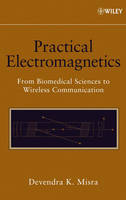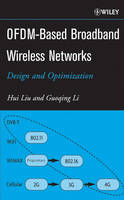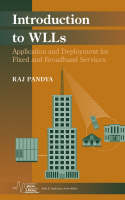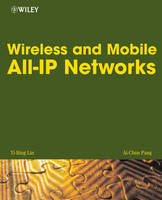4G Wireless Video Communications
 portes grátis
portes grátis
4G Wireless Video Communications
Ci, Song; Wang, Haohong; Kondi, Lisimachos; Luthra, Ajay
John Wiley & Sons Inc
04/2009
420
Dura
Inglês
9780470773079
15 a 20 dias
838
Descrição não disponível.
Forward xiii
Preface xv
About the Authors xxi
About the Series Editors xxv
1 Introduction 1
1.1 Why 4G? 1
1.2 4G Status and Key Technologies 3
1.2.1 3GPP LTE 3
1.2.2 Mobile WiMAX 4
1.3 Video Over Wireless 5
1.3.1 Video Compression Basics 5
1.3.2 Video Coding Standards 9
1.3.3 Error Resilience 10
1.3.4 Network Integration 12
1.3.5 Cross-Layer Design for Wireless Video Delivery 14
1.4 Challenges and Opportunities for 4G Wireless Video 15
References 17
2 Wireless Communications and Networking 19
2.1 Characteristics and Modeling of Wireless Channels 19
2.1.1 Degradation in Radio Propagation 19
2.1.2 Rayleigh Fading Channel 20
2.2 Adaptive Modulation and Coding 23
2.2.1 Basics of Modulation Schemes 23
2.2.2 System Model of AMC 25
2.2.3 Channel Quality Estimation and Prediction 26
2.2.4 Modulation and Coding Parameter Adaptation 28
2.2.5 Estimation Error and Delay in AMC 30
2.2.6 Selection of Adaptation Interval 30
2.3 Orthogonal Frequency Division Multiplexing 31
2.3.1 Background 31
2.3.2 System Model and Implementation 31
2.3.3 Pros and Cons 33
2.4 Multiple-Input Multiple-Output Systems 34
2.4.1 MIMO System Model 34
2.4.2 MIMO Capacity Gain: Multiplexing 35
2.4.3 MIMO Diversity Gain: Beamforming 35
2.4.4 Diversity-Multiplexing Trade-offs 35
2.4.5 Space-Time Coding 36
2.5 Cross-Layer Design of AMC and HARQ 37
2.5.1 Background 38
2.5.2 System Modeling 39
2.5.3 Cross-Layer Design 41
2.5.4 Performance Analysis 44
2.5.5 Performance 45
2.6 Wireless Networking 47
2.6.1 Layering Network Architectures 48
2.6.2 Network Service Models 50
2.6.3 Multiplexing Methods 51
2.6.4 Connection Management in IP-Based Data Networks 53
2.6.5 QoS Handoff 54
2.7 Summary 55
References 56
3 Video Coding and Communications 59
3.1 Digital Video Compression - Why and How Much? 59
3.2 Basics 60
3.2.1 Video Formats 60
3.3 Information Theory 64
3.3.1 Entropy and Mutual Information 65
3.3.2 Encoding of an Information Source 66
3.3.3 Variable Length Coding 68
3.3.4 Quantization 71
3.4 Encoder Architectures 73
3.4.1 DPCM 73
3.4.2 Hybrid Transform-DPCM Architecture 77
3.4.3 A Typical Hybrid Transform DPCM-based Video Codec 79
3.4.4 Motion Compensation 82
3.4.5 DCT and Quantization 83
3.4.6 Procedures Performed at the Decoder 84
3.5 Wavelet-Based Video Compression 86
3.5.1 Motion-Compensated Temporal Wavelet Transform Using Lifting 90
References 94
4 4G Wireless Communications and Networking 97
4.1 IMT-Advanced and 4G 97
4.2 LTE 99
4.2.1 Introduction 101
4.2.2 Protocol Architecture 102
4.2.3 LTE Layer 2 107
4.2.4 The Evolution of Architecture 110
4.2.5 LTE Standardization 110
4.3 WIMAX-IEEE 802.16m 112
4.3.1 Network Architecture 113
4.3.2 System Reference Model 114
4.3.3 Protocol Structure 114
4.3.4 Other Functions Supported by IEEE 802.16m for Further Study 125
4.4 3GPP2 UMB 125
4.4.1 Architecture Reference Model 126
4.4.2 Layering Architecture and Protocols 127
Acknowledgements 133
References 133
5 Advanced Video Coding (AVC)/H.264 Standard 135
5.1 Digital Video Compression Standards 135
5.2 AVC/H.264 Coding Algorithm 138
5.2.1 Temporal Prediction 139
5.2.2 Spatial Prediction 147
5.2.3 The Transform 148
5.2.4 Quantization and Scaling 151
5.2.5 Scanning 151
5.2.6 Variable Length Lossless Codecs 152
5.2.7 Deblocking Filter 155
5.2.8 Hierarchy in the Coded Video 156
5.2.9 Buffers 158
5.2.10 Encapsulation/Packetization 159
5.2.11 Profiles 160
5.2.12 Levels 163
5.2.13 Parameter Sets 167
5.2.14 Supplemental Enhancement Information (SEI) 167
5.2.15 Subjective Tests 168
References 168
6 Content Analysis for Communications 171
6.1 Introduction 171
6.2 Content Analysis 173
6.2.1 Low-Level Feature Extraction 174
6.2.2 Image Segmentation 179
6.2.3 Video Object Segmentation 185
6.2.4 Video Structure Understanding 200
6.2.5 Analysis Methods in Compressed Domain 208
6.3 Content-Based Video Representation 209
6.4 Content-Based Video Coding and Communications 212
6.4.1 Object-Based Video Coding 212
6.4.2 Error Resilience for Object-Based Video 215
6.5 Content Description and Management 217
6.5.1 MPEG-7 217
6.5.2 MPEG-21 219
References 219
7 Video Error Resilience and Error Concealment 223
7.1 Introduction 223
7.2 Error Resilience 224
7.2.1 Resynchronization Markers 224
7.2.2 Reversible Variable Length Coding (RVLC) 225
7.2.3 Error-Resilient Entropy Coding (EREC) 226
7.2.4 Independent Segment Decoding 228
7.2.5 Insertion of Intra Blocks or Frames 228
7.2.6 Scalable Coding 229
7.2.7 Multiple Description Coding 230
7.3 Channel Coding 232
7.4 Error Concealment 234
7.4.1 Intra Error Concealment Techniques 234
7.4.2 Inter Error Concealment Techniques 234
7.5 Error Resilience Features of H.264/AVC 236
7.5.1 Picture Segmentation 236
7.5.2 Intra Placement 236
7.5.3 Reference Picture Selection 237
7.5.4 Data Partitioning 237
7.5.5 Parameter Sets 237
7.5.6 Flexible Macroblock Ordering 238
7.5.7 Redundant Slices (RSs) 239
References 239
8 Cross-Layer Optimized Video Delivery over 4G Wireless Networks 241
8.1 Why Cross-Layer Design? 241
8.2 Quality-Driven Cross-Layer Framework 242
8.3 Application Layer 244
8.4 Rate Control at the Transport Layer 244
8.4.1 Background 244
8.4.2 System Model 246
8.4.3 Network Setting 246
8.4.4 Problem Formulation 248
8.4.5 Problem Solution 248
8.4.6 Performance Evaluation 249
8.5 Routing at the Network Layer 252
8.5.1 Background 252
8.5.2 System Model 254
8.5.3 Routing Metric 255
8.5.4 Problem Formulation 257
8.5.5 Problem Solution 258
8.5.6 Implementation Considerations 262
8.5.7 Performance Evaluation 263
8.6 Content-Aware Real-Time Video Streaming 265
8.6.1 Background 265
8.6.2 Background 265
8.6.3 Problem Formulation 266
8.6.4 Routing Based on Priority Queuing 267
8.6.5 Problem Solution 269
8.6.6 Performance Evaluation 270
8.7 Cross-Layer Optimization for Video Summary Transmission 272
8.7.1 Background 272
8.7.2 Problem Formulation 274
8.7.3 System Model 276
8.7.4 Link Adaptation for Good Content Coverage 278
8.7.5 Problem Solution 280
8.7.6 Performance Evaluation 283
8.8 Conclusions 287
References 287
9 Content-based Video Communications 291
9.1 Network-Adaptive Video Object Encoding 291
9.2 Joint Source Coding and Unequal Error Protection 294
9.2.1 Problem Formulation 295
9.2.2 Solution and Implementation Details 299
9.2.3 Application on Energy-Efficient Wireless Network 301
9.2.4 Application on Differentiated Services Networks 303
9.3 Joint Source-Channel Coding with Utilization of Data Hiding 305
9.3.1 Hiding Shape in Texture 308
9.3.2 Joint Source-Channel Coding 309
9.3.3 Joint Source-Channel Coding and Data Hiding 311
9.3.4 Experimental Results 315
References 322
10 AVC/H.264 Application - Digital TV 325
10.1 Introduction 325
10.1.1 Encoder Flexibility 326
10.2 Random Access 326
10.2.1 GOP Bazaar 327
10.2.2 Buffers, Before and After 332
10.3 Bitstream Splicing 335
10.4 Trick Modes 337
10.4.1 Fast Forward 338
10.4.2 Reverse 338
10.4.3 Pause 338
10.5 Carriage of AVC/H.264 Over MPEG-2 Systems 338
10.5.1 Packetization 339
10.5.2 Audio Video Synchronization 344
10.5.3 Transmitter and Receiver Clock Synchronization 344
10.5.4 System Target Decoder and Timing Model 344
References 345
11 Interactive Video Communications 347
11.1 Video Conferencing and Telephony 347
11.1.1 IP and Broadband Video Telephony 347
11.1.2 Wireless Video Telephony 348
11.1.3 3G-324M Protocol 348
11.2 Region-of-Interest Video Communications 351
11.2.1 ROI based Bit Allocation 351
11.2.2 Content Adaptive Background Skipping 356
References 366
12 Wireless Video Streaming 369
12.1 Introduction 369
12.2 Streaming System Architecture 370
12.2.1 Video Compression 370
12.2.2 Application Layer QoS Control 372
12.2.3 Protocols 374
12.2.4 Video/Audio Synchronization 376
12.3 Delay-Constrained Retransmission 377
12.3.1 Receiver-Based Control 378
12.3.2 Sender-Based Control 378
12.3.3 Hybrid Control 379
12.3.4 Rate-Distortion Optimal Retransmission 379
12.4 Considerations for Wireless Video Streaming 382
12.4.1 Cross-Layer Optimization and Physical Layer Consideration 383
12.5 P2P Video Streaming 384
References 385
Index 389
Preface xv
About the Authors xxi
About the Series Editors xxv
1 Introduction 1
1.1 Why 4G? 1
1.2 4G Status and Key Technologies 3
1.2.1 3GPP LTE 3
1.2.2 Mobile WiMAX 4
1.3 Video Over Wireless 5
1.3.1 Video Compression Basics 5
1.3.2 Video Coding Standards 9
1.3.3 Error Resilience 10
1.3.4 Network Integration 12
1.3.5 Cross-Layer Design for Wireless Video Delivery 14
1.4 Challenges and Opportunities for 4G Wireless Video 15
References 17
2 Wireless Communications and Networking 19
2.1 Characteristics and Modeling of Wireless Channels 19
2.1.1 Degradation in Radio Propagation 19
2.1.2 Rayleigh Fading Channel 20
2.2 Adaptive Modulation and Coding 23
2.2.1 Basics of Modulation Schemes 23
2.2.2 System Model of AMC 25
2.2.3 Channel Quality Estimation and Prediction 26
2.2.4 Modulation and Coding Parameter Adaptation 28
2.2.5 Estimation Error and Delay in AMC 30
2.2.6 Selection of Adaptation Interval 30
2.3 Orthogonal Frequency Division Multiplexing 31
2.3.1 Background 31
2.3.2 System Model and Implementation 31
2.3.3 Pros and Cons 33
2.4 Multiple-Input Multiple-Output Systems 34
2.4.1 MIMO System Model 34
2.4.2 MIMO Capacity Gain: Multiplexing 35
2.4.3 MIMO Diversity Gain: Beamforming 35
2.4.4 Diversity-Multiplexing Trade-offs 35
2.4.5 Space-Time Coding 36
2.5 Cross-Layer Design of AMC and HARQ 37
2.5.1 Background 38
2.5.2 System Modeling 39
2.5.3 Cross-Layer Design 41
2.5.4 Performance Analysis 44
2.5.5 Performance 45
2.6 Wireless Networking 47
2.6.1 Layering Network Architectures 48
2.6.2 Network Service Models 50
2.6.3 Multiplexing Methods 51
2.6.4 Connection Management in IP-Based Data Networks 53
2.6.5 QoS Handoff 54
2.7 Summary 55
References 56
3 Video Coding and Communications 59
3.1 Digital Video Compression - Why and How Much? 59
3.2 Basics 60
3.2.1 Video Formats 60
3.3 Information Theory 64
3.3.1 Entropy and Mutual Information 65
3.3.2 Encoding of an Information Source 66
3.3.3 Variable Length Coding 68
3.3.4 Quantization 71
3.4 Encoder Architectures 73
3.4.1 DPCM 73
3.4.2 Hybrid Transform-DPCM Architecture 77
3.4.3 A Typical Hybrid Transform DPCM-based Video Codec 79
3.4.4 Motion Compensation 82
3.4.5 DCT and Quantization 83
3.4.6 Procedures Performed at the Decoder 84
3.5 Wavelet-Based Video Compression 86
3.5.1 Motion-Compensated Temporal Wavelet Transform Using Lifting 90
References 94
4 4G Wireless Communications and Networking 97
4.1 IMT-Advanced and 4G 97
4.2 LTE 99
4.2.1 Introduction 101
4.2.2 Protocol Architecture 102
4.2.3 LTE Layer 2 107
4.2.4 The Evolution of Architecture 110
4.2.5 LTE Standardization 110
4.3 WIMAX-IEEE 802.16m 112
4.3.1 Network Architecture 113
4.3.2 System Reference Model 114
4.3.3 Protocol Structure 114
4.3.4 Other Functions Supported by IEEE 802.16m for Further Study 125
4.4 3GPP2 UMB 125
4.4.1 Architecture Reference Model 126
4.4.2 Layering Architecture and Protocols 127
Acknowledgements 133
References 133
5 Advanced Video Coding (AVC)/H.264 Standard 135
5.1 Digital Video Compression Standards 135
5.2 AVC/H.264 Coding Algorithm 138
5.2.1 Temporal Prediction 139
5.2.2 Spatial Prediction 147
5.2.3 The Transform 148
5.2.4 Quantization and Scaling 151
5.2.5 Scanning 151
5.2.6 Variable Length Lossless Codecs 152
5.2.7 Deblocking Filter 155
5.2.8 Hierarchy in the Coded Video 156
5.2.9 Buffers 158
5.2.10 Encapsulation/Packetization 159
5.2.11 Profiles 160
5.2.12 Levels 163
5.2.13 Parameter Sets 167
5.2.14 Supplemental Enhancement Information (SEI) 167
5.2.15 Subjective Tests 168
References 168
6 Content Analysis for Communications 171
6.1 Introduction 171
6.2 Content Analysis 173
6.2.1 Low-Level Feature Extraction 174
6.2.2 Image Segmentation 179
6.2.3 Video Object Segmentation 185
6.2.4 Video Structure Understanding 200
6.2.5 Analysis Methods in Compressed Domain 208
6.3 Content-Based Video Representation 209
6.4 Content-Based Video Coding and Communications 212
6.4.1 Object-Based Video Coding 212
6.4.2 Error Resilience for Object-Based Video 215
6.5 Content Description and Management 217
6.5.1 MPEG-7 217
6.5.2 MPEG-21 219
References 219
7 Video Error Resilience and Error Concealment 223
7.1 Introduction 223
7.2 Error Resilience 224
7.2.1 Resynchronization Markers 224
7.2.2 Reversible Variable Length Coding (RVLC) 225
7.2.3 Error-Resilient Entropy Coding (EREC) 226
7.2.4 Independent Segment Decoding 228
7.2.5 Insertion of Intra Blocks or Frames 228
7.2.6 Scalable Coding 229
7.2.7 Multiple Description Coding 230
7.3 Channel Coding 232
7.4 Error Concealment 234
7.4.1 Intra Error Concealment Techniques 234
7.4.2 Inter Error Concealment Techniques 234
7.5 Error Resilience Features of H.264/AVC 236
7.5.1 Picture Segmentation 236
7.5.2 Intra Placement 236
7.5.3 Reference Picture Selection 237
7.5.4 Data Partitioning 237
7.5.5 Parameter Sets 237
7.5.6 Flexible Macroblock Ordering 238
7.5.7 Redundant Slices (RSs) 239
References 239
8 Cross-Layer Optimized Video Delivery over 4G Wireless Networks 241
8.1 Why Cross-Layer Design? 241
8.2 Quality-Driven Cross-Layer Framework 242
8.3 Application Layer 244
8.4 Rate Control at the Transport Layer 244
8.4.1 Background 244
8.4.2 System Model 246
8.4.3 Network Setting 246
8.4.4 Problem Formulation 248
8.4.5 Problem Solution 248
8.4.6 Performance Evaluation 249
8.5 Routing at the Network Layer 252
8.5.1 Background 252
8.5.2 System Model 254
8.5.3 Routing Metric 255
8.5.4 Problem Formulation 257
8.5.5 Problem Solution 258
8.5.6 Implementation Considerations 262
8.5.7 Performance Evaluation 263
8.6 Content-Aware Real-Time Video Streaming 265
8.6.1 Background 265
8.6.2 Background 265
8.6.3 Problem Formulation 266
8.6.4 Routing Based on Priority Queuing 267
8.6.5 Problem Solution 269
8.6.6 Performance Evaluation 270
8.7 Cross-Layer Optimization for Video Summary Transmission 272
8.7.1 Background 272
8.7.2 Problem Formulation 274
8.7.3 System Model 276
8.7.4 Link Adaptation for Good Content Coverage 278
8.7.5 Problem Solution 280
8.7.6 Performance Evaluation 283
8.8 Conclusions 287
References 287
9 Content-based Video Communications 291
9.1 Network-Adaptive Video Object Encoding 291
9.2 Joint Source Coding and Unequal Error Protection 294
9.2.1 Problem Formulation 295
9.2.2 Solution and Implementation Details 299
9.2.3 Application on Energy-Efficient Wireless Network 301
9.2.4 Application on Differentiated Services Networks 303
9.3 Joint Source-Channel Coding with Utilization of Data Hiding 305
9.3.1 Hiding Shape in Texture 308
9.3.2 Joint Source-Channel Coding 309
9.3.3 Joint Source-Channel Coding and Data Hiding 311
9.3.4 Experimental Results 315
References 322
10 AVC/H.264 Application - Digital TV 325
10.1 Introduction 325
10.1.1 Encoder Flexibility 326
10.2 Random Access 326
10.2.1 GOP Bazaar 327
10.2.2 Buffers, Before and After 332
10.3 Bitstream Splicing 335
10.4 Trick Modes 337
10.4.1 Fast Forward 338
10.4.2 Reverse 338
10.4.3 Pause 338
10.5 Carriage of AVC/H.264 Over MPEG-2 Systems 338
10.5.1 Packetization 339
10.5.2 Audio Video Synchronization 344
10.5.3 Transmitter and Receiver Clock Synchronization 344
10.5.4 System Target Decoder and Timing Model 344
References 345
11 Interactive Video Communications 347
11.1 Video Conferencing and Telephony 347
11.1.1 IP and Broadband Video Telephony 347
11.1.2 Wireless Video Telephony 348
11.1.3 3G-324M Protocol 348
11.2 Region-of-Interest Video Communications 351
11.2.1 ROI based Bit Allocation 351
11.2.2 Content Adaptive Background Skipping 356
References 366
12 Wireless Video Streaming 369
12.1 Introduction 369
12.2 Streaming System Architecture 370
12.2.1 Video Compression 370
12.2.2 Application Layer QoS Control 372
12.2.3 Protocols 374
12.2.4 Video/Audio Synchronization 376
12.3 Delay-Constrained Retransmission 377
12.3.1 Receiver-Based Control 378
12.3.2 Sender-Based Control 378
12.3.3 Hybrid Control 379
12.3.4 Rate-Distortion Optimal Retransmission 379
12.4 Considerations for Wireless Video Streaming 382
12.4.1 Cross-Layer Optimization and Physical Layer Consideration 383
12.5 P2P Video Streaming 384
References 385
Index 389
Este título pertence ao(s) assunto(s) indicados(s). Para ver outros títulos clique no assunto desejado.
communication; comprehensive presentation; video; multimedia; book; ubiquitous; examines; systems; wireless; fundamental; descriptions; focus; theory; digital; g; topics; key; networks; error
Forward xiii
Preface xv
About the Authors xxi
About the Series Editors xxv
1 Introduction 1
1.1 Why 4G? 1
1.2 4G Status and Key Technologies 3
1.2.1 3GPP LTE 3
1.2.2 Mobile WiMAX 4
1.3 Video Over Wireless 5
1.3.1 Video Compression Basics 5
1.3.2 Video Coding Standards 9
1.3.3 Error Resilience 10
1.3.4 Network Integration 12
1.3.5 Cross-Layer Design for Wireless Video Delivery 14
1.4 Challenges and Opportunities for 4G Wireless Video 15
References 17
2 Wireless Communications and Networking 19
2.1 Characteristics and Modeling of Wireless Channels 19
2.1.1 Degradation in Radio Propagation 19
2.1.2 Rayleigh Fading Channel 20
2.2 Adaptive Modulation and Coding 23
2.2.1 Basics of Modulation Schemes 23
2.2.2 System Model of AMC 25
2.2.3 Channel Quality Estimation and Prediction 26
2.2.4 Modulation and Coding Parameter Adaptation 28
2.2.5 Estimation Error and Delay in AMC 30
2.2.6 Selection of Adaptation Interval 30
2.3 Orthogonal Frequency Division Multiplexing 31
2.3.1 Background 31
2.3.2 System Model and Implementation 31
2.3.3 Pros and Cons 33
2.4 Multiple-Input Multiple-Output Systems 34
2.4.1 MIMO System Model 34
2.4.2 MIMO Capacity Gain: Multiplexing 35
2.4.3 MIMO Diversity Gain: Beamforming 35
2.4.4 Diversity-Multiplexing Trade-offs 35
2.4.5 Space-Time Coding 36
2.5 Cross-Layer Design of AMC and HARQ 37
2.5.1 Background 38
2.5.2 System Modeling 39
2.5.3 Cross-Layer Design 41
2.5.4 Performance Analysis 44
2.5.5 Performance 45
2.6 Wireless Networking 47
2.6.1 Layering Network Architectures 48
2.6.2 Network Service Models 50
2.6.3 Multiplexing Methods 51
2.6.4 Connection Management in IP-Based Data Networks 53
2.6.5 QoS Handoff 54
2.7 Summary 55
References 56
3 Video Coding and Communications 59
3.1 Digital Video Compression - Why and How Much? 59
3.2 Basics 60
3.2.1 Video Formats 60
3.3 Information Theory 64
3.3.1 Entropy and Mutual Information 65
3.3.2 Encoding of an Information Source 66
3.3.3 Variable Length Coding 68
3.3.4 Quantization 71
3.4 Encoder Architectures 73
3.4.1 DPCM 73
3.4.2 Hybrid Transform-DPCM Architecture 77
3.4.3 A Typical Hybrid Transform DPCM-based Video Codec 79
3.4.4 Motion Compensation 82
3.4.5 DCT and Quantization 83
3.4.6 Procedures Performed at the Decoder 84
3.5 Wavelet-Based Video Compression 86
3.5.1 Motion-Compensated Temporal Wavelet Transform Using Lifting 90
References 94
4 4G Wireless Communications and Networking 97
4.1 IMT-Advanced and 4G 97
4.2 LTE 99
4.2.1 Introduction 101
4.2.2 Protocol Architecture 102
4.2.3 LTE Layer 2 107
4.2.4 The Evolution of Architecture 110
4.2.5 LTE Standardization 110
4.3 WIMAX-IEEE 802.16m 112
4.3.1 Network Architecture 113
4.3.2 System Reference Model 114
4.3.3 Protocol Structure 114
4.3.4 Other Functions Supported by IEEE 802.16m for Further Study 125
4.4 3GPP2 UMB 125
4.4.1 Architecture Reference Model 126
4.4.2 Layering Architecture and Protocols 127
Acknowledgements 133
References 133
5 Advanced Video Coding (AVC)/H.264 Standard 135
5.1 Digital Video Compression Standards 135
5.2 AVC/H.264 Coding Algorithm 138
5.2.1 Temporal Prediction 139
5.2.2 Spatial Prediction 147
5.2.3 The Transform 148
5.2.4 Quantization and Scaling 151
5.2.5 Scanning 151
5.2.6 Variable Length Lossless Codecs 152
5.2.7 Deblocking Filter 155
5.2.8 Hierarchy in the Coded Video 156
5.2.9 Buffers 158
5.2.10 Encapsulation/Packetization 159
5.2.11 Profiles 160
5.2.12 Levels 163
5.2.13 Parameter Sets 167
5.2.14 Supplemental Enhancement Information (SEI) 167
5.2.15 Subjective Tests 168
References 168
6 Content Analysis for Communications 171
6.1 Introduction 171
6.2 Content Analysis 173
6.2.1 Low-Level Feature Extraction 174
6.2.2 Image Segmentation 179
6.2.3 Video Object Segmentation 185
6.2.4 Video Structure Understanding 200
6.2.5 Analysis Methods in Compressed Domain 208
6.3 Content-Based Video Representation 209
6.4 Content-Based Video Coding and Communications 212
6.4.1 Object-Based Video Coding 212
6.4.2 Error Resilience for Object-Based Video 215
6.5 Content Description and Management 217
6.5.1 MPEG-7 217
6.5.2 MPEG-21 219
References 219
7 Video Error Resilience and Error Concealment 223
7.1 Introduction 223
7.2 Error Resilience 224
7.2.1 Resynchronization Markers 224
7.2.2 Reversible Variable Length Coding (RVLC) 225
7.2.3 Error-Resilient Entropy Coding (EREC) 226
7.2.4 Independent Segment Decoding 228
7.2.5 Insertion of Intra Blocks or Frames 228
7.2.6 Scalable Coding 229
7.2.7 Multiple Description Coding 230
7.3 Channel Coding 232
7.4 Error Concealment 234
7.4.1 Intra Error Concealment Techniques 234
7.4.2 Inter Error Concealment Techniques 234
7.5 Error Resilience Features of H.264/AVC 236
7.5.1 Picture Segmentation 236
7.5.2 Intra Placement 236
7.5.3 Reference Picture Selection 237
7.5.4 Data Partitioning 237
7.5.5 Parameter Sets 237
7.5.6 Flexible Macroblock Ordering 238
7.5.7 Redundant Slices (RSs) 239
References 239
8 Cross-Layer Optimized Video Delivery over 4G Wireless Networks 241
8.1 Why Cross-Layer Design? 241
8.2 Quality-Driven Cross-Layer Framework 242
8.3 Application Layer 244
8.4 Rate Control at the Transport Layer 244
8.4.1 Background 244
8.4.2 System Model 246
8.4.3 Network Setting 246
8.4.4 Problem Formulation 248
8.4.5 Problem Solution 248
8.4.6 Performance Evaluation 249
8.5 Routing at the Network Layer 252
8.5.1 Background 252
8.5.2 System Model 254
8.5.3 Routing Metric 255
8.5.4 Problem Formulation 257
8.5.5 Problem Solution 258
8.5.6 Implementation Considerations 262
8.5.7 Performance Evaluation 263
8.6 Content-Aware Real-Time Video Streaming 265
8.6.1 Background 265
8.6.2 Background 265
8.6.3 Problem Formulation 266
8.6.4 Routing Based on Priority Queuing 267
8.6.5 Problem Solution 269
8.6.6 Performance Evaluation 270
8.7 Cross-Layer Optimization for Video Summary Transmission 272
8.7.1 Background 272
8.7.2 Problem Formulation 274
8.7.3 System Model 276
8.7.4 Link Adaptation for Good Content Coverage 278
8.7.5 Problem Solution 280
8.7.6 Performance Evaluation 283
8.8 Conclusions 287
References 287
9 Content-based Video Communications 291
9.1 Network-Adaptive Video Object Encoding 291
9.2 Joint Source Coding and Unequal Error Protection 294
9.2.1 Problem Formulation 295
9.2.2 Solution and Implementation Details 299
9.2.3 Application on Energy-Efficient Wireless Network 301
9.2.4 Application on Differentiated Services Networks 303
9.3 Joint Source-Channel Coding with Utilization of Data Hiding 305
9.3.1 Hiding Shape in Texture 308
9.3.2 Joint Source-Channel Coding 309
9.3.3 Joint Source-Channel Coding and Data Hiding 311
9.3.4 Experimental Results 315
References 322
10 AVC/H.264 Application - Digital TV 325
10.1 Introduction 325
10.1.1 Encoder Flexibility 326
10.2 Random Access 326
10.2.1 GOP Bazaar 327
10.2.2 Buffers, Before and After 332
10.3 Bitstream Splicing 335
10.4 Trick Modes 337
10.4.1 Fast Forward 338
10.4.2 Reverse 338
10.4.3 Pause 338
10.5 Carriage of AVC/H.264 Over MPEG-2 Systems 338
10.5.1 Packetization 339
10.5.2 Audio Video Synchronization 344
10.5.3 Transmitter and Receiver Clock Synchronization 344
10.5.4 System Target Decoder and Timing Model 344
References 345
11 Interactive Video Communications 347
11.1 Video Conferencing and Telephony 347
11.1.1 IP and Broadband Video Telephony 347
11.1.2 Wireless Video Telephony 348
11.1.3 3G-324M Protocol 348
11.2 Region-of-Interest Video Communications 351
11.2.1 ROI based Bit Allocation 351
11.2.2 Content Adaptive Background Skipping 356
References 366
12 Wireless Video Streaming 369
12.1 Introduction 369
12.2 Streaming System Architecture 370
12.2.1 Video Compression 370
12.2.2 Application Layer QoS Control 372
12.2.3 Protocols 374
12.2.4 Video/Audio Synchronization 376
12.3 Delay-Constrained Retransmission 377
12.3.1 Receiver-Based Control 378
12.3.2 Sender-Based Control 378
12.3.3 Hybrid Control 379
12.3.4 Rate-Distortion Optimal Retransmission 379
12.4 Considerations for Wireless Video Streaming 382
12.4.1 Cross-Layer Optimization and Physical Layer Consideration 383
12.5 P2P Video Streaming 384
References 385
Index 389
Preface xv
About the Authors xxi
About the Series Editors xxv
1 Introduction 1
1.1 Why 4G? 1
1.2 4G Status and Key Technologies 3
1.2.1 3GPP LTE 3
1.2.2 Mobile WiMAX 4
1.3 Video Over Wireless 5
1.3.1 Video Compression Basics 5
1.3.2 Video Coding Standards 9
1.3.3 Error Resilience 10
1.3.4 Network Integration 12
1.3.5 Cross-Layer Design for Wireless Video Delivery 14
1.4 Challenges and Opportunities for 4G Wireless Video 15
References 17
2 Wireless Communications and Networking 19
2.1 Characteristics and Modeling of Wireless Channels 19
2.1.1 Degradation in Radio Propagation 19
2.1.2 Rayleigh Fading Channel 20
2.2 Adaptive Modulation and Coding 23
2.2.1 Basics of Modulation Schemes 23
2.2.2 System Model of AMC 25
2.2.3 Channel Quality Estimation and Prediction 26
2.2.4 Modulation and Coding Parameter Adaptation 28
2.2.5 Estimation Error and Delay in AMC 30
2.2.6 Selection of Adaptation Interval 30
2.3 Orthogonal Frequency Division Multiplexing 31
2.3.1 Background 31
2.3.2 System Model and Implementation 31
2.3.3 Pros and Cons 33
2.4 Multiple-Input Multiple-Output Systems 34
2.4.1 MIMO System Model 34
2.4.2 MIMO Capacity Gain: Multiplexing 35
2.4.3 MIMO Diversity Gain: Beamforming 35
2.4.4 Diversity-Multiplexing Trade-offs 35
2.4.5 Space-Time Coding 36
2.5 Cross-Layer Design of AMC and HARQ 37
2.5.1 Background 38
2.5.2 System Modeling 39
2.5.3 Cross-Layer Design 41
2.5.4 Performance Analysis 44
2.5.5 Performance 45
2.6 Wireless Networking 47
2.6.1 Layering Network Architectures 48
2.6.2 Network Service Models 50
2.6.3 Multiplexing Methods 51
2.6.4 Connection Management in IP-Based Data Networks 53
2.6.5 QoS Handoff 54
2.7 Summary 55
References 56
3 Video Coding and Communications 59
3.1 Digital Video Compression - Why and How Much? 59
3.2 Basics 60
3.2.1 Video Formats 60
3.3 Information Theory 64
3.3.1 Entropy and Mutual Information 65
3.3.2 Encoding of an Information Source 66
3.3.3 Variable Length Coding 68
3.3.4 Quantization 71
3.4 Encoder Architectures 73
3.4.1 DPCM 73
3.4.2 Hybrid Transform-DPCM Architecture 77
3.4.3 A Typical Hybrid Transform DPCM-based Video Codec 79
3.4.4 Motion Compensation 82
3.4.5 DCT and Quantization 83
3.4.6 Procedures Performed at the Decoder 84
3.5 Wavelet-Based Video Compression 86
3.5.1 Motion-Compensated Temporal Wavelet Transform Using Lifting 90
References 94
4 4G Wireless Communications and Networking 97
4.1 IMT-Advanced and 4G 97
4.2 LTE 99
4.2.1 Introduction 101
4.2.2 Protocol Architecture 102
4.2.3 LTE Layer 2 107
4.2.4 The Evolution of Architecture 110
4.2.5 LTE Standardization 110
4.3 WIMAX-IEEE 802.16m 112
4.3.1 Network Architecture 113
4.3.2 System Reference Model 114
4.3.3 Protocol Structure 114
4.3.4 Other Functions Supported by IEEE 802.16m for Further Study 125
4.4 3GPP2 UMB 125
4.4.1 Architecture Reference Model 126
4.4.2 Layering Architecture and Protocols 127
Acknowledgements 133
References 133
5 Advanced Video Coding (AVC)/H.264 Standard 135
5.1 Digital Video Compression Standards 135
5.2 AVC/H.264 Coding Algorithm 138
5.2.1 Temporal Prediction 139
5.2.2 Spatial Prediction 147
5.2.3 The Transform 148
5.2.4 Quantization and Scaling 151
5.2.5 Scanning 151
5.2.6 Variable Length Lossless Codecs 152
5.2.7 Deblocking Filter 155
5.2.8 Hierarchy in the Coded Video 156
5.2.9 Buffers 158
5.2.10 Encapsulation/Packetization 159
5.2.11 Profiles 160
5.2.12 Levels 163
5.2.13 Parameter Sets 167
5.2.14 Supplemental Enhancement Information (SEI) 167
5.2.15 Subjective Tests 168
References 168
6 Content Analysis for Communications 171
6.1 Introduction 171
6.2 Content Analysis 173
6.2.1 Low-Level Feature Extraction 174
6.2.2 Image Segmentation 179
6.2.3 Video Object Segmentation 185
6.2.4 Video Structure Understanding 200
6.2.5 Analysis Methods in Compressed Domain 208
6.3 Content-Based Video Representation 209
6.4 Content-Based Video Coding and Communications 212
6.4.1 Object-Based Video Coding 212
6.4.2 Error Resilience for Object-Based Video 215
6.5 Content Description and Management 217
6.5.1 MPEG-7 217
6.5.2 MPEG-21 219
References 219
7 Video Error Resilience and Error Concealment 223
7.1 Introduction 223
7.2 Error Resilience 224
7.2.1 Resynchronization Markers 224
7.2.2 Reversible Variable Length Coding (RVLC) 225
7.2.3 Error-Resilient Entropy Coding (EREC) 226
7.2.4 Independent Segment Decoding 228
7.2.5 Insertion of Intra Blocks or Frames 228
7.2.6 Scalable Coding 229
7.2.7 Multiple Description Coding 230
7.3 Channel Coding 232
7.4 Error Concealment 234
7.4.1 Intra Error Concealment Techniques 234
7.4.2 Inter Error Concealment Techniques 234
7.5 Error Resilience Features of H.264/AVC 236
7.5.1 Picture Segmentation 236
7.5.2 Intra Placement 236
7.5.3 Reference Picture Selection 237
7.5.4 Data Partitioning 237
7.5.5 Parameter Sets 237
7.5.6 Flexible Macroblock Ordering 238
7.5.7 Redundant Slices (RSs) 239
References 239
8 Cross-Layer Optimized Video Delivery over 4G Wireless Networks 241
8.1 Why Cross-Layer Design? 241
8.2 Quality-Driven Cross-Layer Framework 242
8.3 Application Layer 244
8.4 Rate Control at the Transport Layer 244
8.4.1 Background 244
8.4.2 System Model 246
8.4.3 Network Setting 246
8.4.4 Problem Formulation 248
8.4.5 Problem Solution 248
8.4.6 Performance Evaluation 249
8.5 Routing at the Network Layer 252
8.5.1 Background 252
8.5.2 System Model 254
8.5.3 Routing Metric 255
8.5.4 Problem Formulation 257
8.5.5 Problem Solution 258
8.5.6 Implementation Considerations 262
8.5.7 Performance Evaluation 263
8.6 Content-Aware Real-Time Video Streaming 265
8.6.1 Background 265
8.6.2 Background 265
8.6.3 Problem Formulation 266
8.6.4 Routing Based on Priority Queuing 267
8.6.5 Problem Solution 269
8.6.6 Performance Evaluation 270
8.7 Cross-Layer Optimization for Video Summary Transmission 272
8.7.1 Background 272
8.7.2 Problem Formulation 274
8.7.3 System Model 276
8.7.4 Link Adaptation for Good Content Coverage 278
8.7.5 Problem Solution 280
8.7.6 Performance Evaluation 283
8.8 Conclusions 287
References 287
9 Content-based Video Communications 291
9.1 Network-Adaptive Video Object Encoding 291
9.2 Joint Source Coding and Unequal Error Protection 294
9.2.1 Problem Formulation 295
9.2.2 Solution and Implementation Details 299
9.2.3 Application on Energy-Efficient Wireless Network 301
9.2.4 Application on Differentiated Services Networks 303
9.3 Joint Source-Channel Coding with Utilization of Data Hiding 305
9.3.1 Hiding Shape in Texture 308
9.3.2 Joint Source-Channel Coding 309
9.3.3 Joint Source-Channel Coding and Data Hiding 311
9.3.4 Experimental Results 315
References 322
10 AVC/H.264 Application - Digital TV 325
10.1 Introduction 325
10.1.1 Encoder Flexibility 326
10.2 Random Access 326
10.2.1 GOP Bazaar 327
10.2.2 Buffers, Before and After 332
10.3 Bitstream Splicing 335
10.4 Trick Modes 337
10.4.1 Fast Forward 338
10.4.2 Reverse 338
10.4.3 Pause 338
10.5 Carriage of AVC/H.264 Over MPEG-2 Systems 338
10.5.1 Packetization 339
10.5.2 Audio Video Synchronization 344
10.5.3 Transmitter and Receiver Clock Synchronization 344
10.5.4 System Target Decoder and Timing Model 344
References 345
11 Interactive Video Communications 347
11.1 Video Conferencing and Telephony 347
11.1.1 IP and Broadband Video Telephony 347
11.1.2 Wireless Video Telephony 348
11.1.3 3G-324M Protocol 348
11.2 Region-of-Interest Video Communications 351
11.2.1 ROI based Bit Allocation 351
11.2.2 Content Adaptive Background Skipping 356
References 366
12 Wireless Video Streaming 369
12.1 Introduction 369
12.2 Streaming System Architecture 370
12.2.1 Video Compression 370
12.2.2 Application Layer QoS Control 372
12.2.3 Protocols 374
12.2.4 Video/Audio Synchronization 376
12.3 Delay-Constrained Retransmission 377
12.3.1 Receiver-Based Control 378
12.3.2 Sender-Based Control 378
12.3.3 Hybrid Control 379
12.3.4 Rate-Distortion Optimal Retransmission 379
12.4 Considerations for Wireless Video Streaming 382
12.4.1 Cross-Layer Optimization and Physical Layer Consideration 383
12.5 P2P Video Streaming 384
References 385
Index 389
Este título pertence ao(s) assunto(s) indicados(s). Para ver outros títulos clique no assunto desejado.











